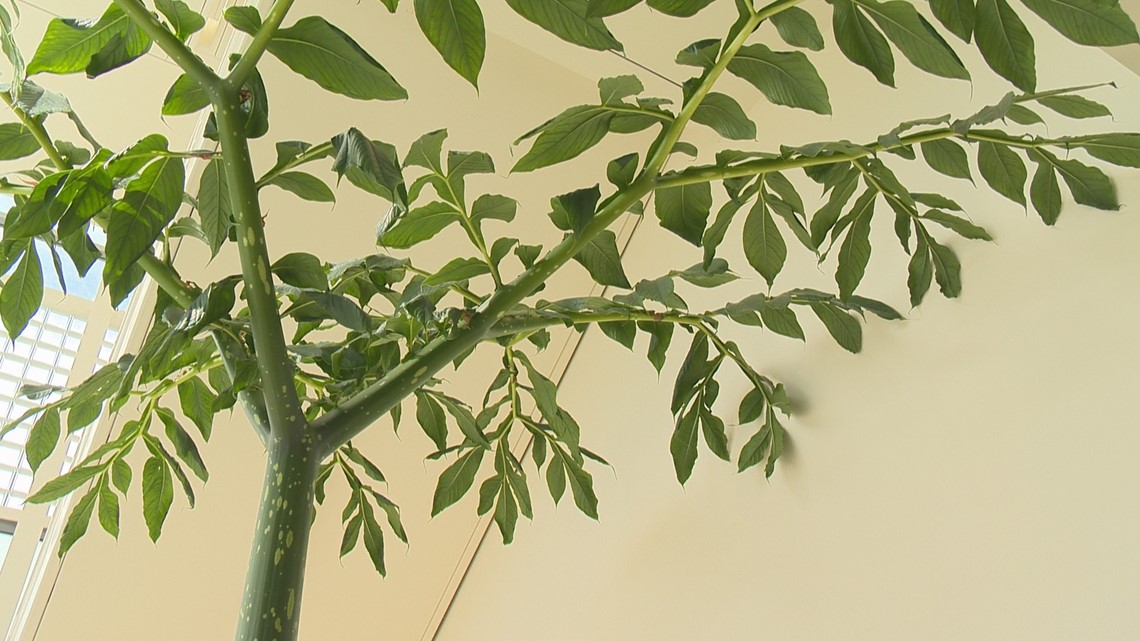VANCOUVER, Wash. — UPDATE: The corpse flower started to bloom on June 29.
ORIGINAL STORY:
One of the largest and rarest flowers in the world is expected to bloom soon at Washington State University Vancouver.
The corpse flower, which students have named Titan VanCoug, is getting ready to bloom for the third time. The first bloom came in 2019 after laying dormant for 17 years. The second one was in 2022 and it drew 20,000 visitors to campus.
"It's really neat to have a bloom right after we just had a bloom," said Dawn Freeman, an instruction and class support technician at WSU Vancouver.
She has spent the past few years caring for the plant.
The corpse flower could bloom at the end of June or the first of July, according to WSU Vancouver's website. However, Freeman said it's still too early to tell. She thinks she will have a better idea of the timeline in the next week or two.
"Last year's bloom was in August when it was hotter and warmer, and I think it sped things up in general," Freeman said. "This has been cooler, the weather just got kind of cold again, so there's been sometimes where there's been no growth on this, which is kind of odd."
Freeman said she noticed what she called an "emergence" coming out of the soil in mid-May. That emergence has grown about two to three inches a day and now stands around four feet. It's unclear whether it will produce a flower or leaves, but Freeman suspects it will be a flower.


Titan VanCoug's corm cloned years ago, so four plants currently reside in one pot. A corm, or a tuber, is an underground stem that stores nutrients and acts similarly as bulbs do in other plants. Currently, visitors can see three stages of life in one pot: There is a leaf from a corm that bloomed in 2019, fruit from the 2022 bloom as well as the emergence of the 2023 bloom.


What makes corpse flowers unique?
Corpse flowers are indigenous to only one side of a mountain ridge in Sumatra, an island in Indonesia. What also makes them unique is the powerful stench which it emits when it blooms. Some people have compared the aroma to a rotting corpse, hence it's name, or dirty socks.
"It stinks. That’s because its pollinators are flies, corpse flies, dung beetles and things like that," Freeman said.
Corpse flowers usually bloom once every year or two, and the bloom only lasts two to three days. Bloom can grow up to 8 feet tall.
How to see Titan VanCoug when it blooms
Titan VanCoug is usually taken outside as soon as it blooms because of its smell. However, this year staff have decided not to move it from its current home — the stairwell of WSU Vancouver's Science and Engineering Building — because they didn't want to disturb it as it prepares to bloom.
Community members will still be able to view it in person and can check WSU Vancouver's website for updates.
The university has also set up a livestream of the plant on YouTube.
The history of Titan VanCoug
Back in 2002, former WSU Vancouver Professor Emeritus Steve Sylvester planted a seed from the University of Wisconsin-Madison's corpse flower. Titan VanCoug was a late bloomer, and after 17 years, finally had its first bloom in July 2019.
Sylvester retired in 2021 and Freeman began taking care of the corpse flower.

